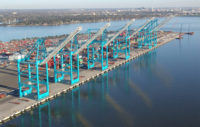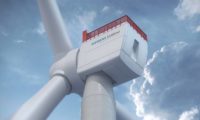Alternative Energy
Siemens Marshals Resources Behind Wind Energy With Spanish Deal
The company has a pending tie-up with Spanish manufacturer Gamesa

The larger turbines have a rear-mounted work platform cage that provides two levels of access for maintenance.
Photo courtesy Siemens
German engineering giant Siemens will be consolidating its position as a power player in the wind-energy business with its pending deal with Spanish manufacturer Gamesa, industry watchers say.
The two firms recently agreed to merge their wind-power operations in what could be a $1-billion transaction. If the deal closes as planned in the first part of 2017. It will create the world’s biggest wind-turbine maker and signals Siemens' continued growth in wind energy, especially offshore, in emerging markets and in supplying onshore services, according to company officials.
As wind-energy infrastructure construction gains momentum, the turbine manufacturing business will be there to pad Siemens’s overall renewables operation, which took in about $6.4 billion during its most recent fiscal year, pushing its market share in the global wind-power industry to 8.1%. The combined Siemens-Gamesa venture will boost that to about 14%.
Siemens and Gamesa won orders to produce about 280 new 2.3- and 2.1-megawatt turbines, as Windpower Monthly reported, for installation in New Mexico and Texas. The first U.S. offshore wind operation—with turbines and support supplied by GE and blades built in Denmark by a GE subsidiary—is expected to be generating power off Block Island, R.I., by the end of the year. Construction action on the cable connections and turbine blades ramped up at the beginning of the month. Freshwater offshore wind startups, such as Icebreaker in Lake Erie, also are progressing.
Jérôme Guillet, the managing director of Paris-based renewable-energy financing advisers Green Giraffe and a frequent partner in financing offshore wind projects, says the Siemens-Gamesa deal will put the company in a better position to compete to supply new wind-farm construction. “The two companies are quite complementary,” he says.
Here's how the deal is structured: Siemens is intergrating its wind-energy business, including all manufacturing and servicing, into the existing Gamesa. The Spanish company's shareholders will get €3.75 per share (US$4.32) in cash. Then, Siemens would hold a 59% share in the combined venture, with Gamesa shareholders holding the remainder; the headquarters of the new business will remain in Zamudio, Spain, outside of Bilbao. An onshore division will be run from Spain, and an offshore division will be run from Vejle, Denmark, and Hamburg, Germany.
Guillet notes that Siemens has a large offshore business and is strong in Europe and North America. For example, the company has manufacturing operations in Kansas, Iowa and Canada. Gamesa is strong in Latin America and in emerging markets such as India, China and Brazil; it also has its own production facility in China. For the most part, Gamesa's growth markets are positioned onshore; Siemens' growth markets are mostly offshore. Once the merger is complete, the combined firm will have booked about €20 billion (US$23 billion) in back orders.
“Our goal is to bring the costs of wind power down to make it more competitive with other sources of energy,” says Eva-Maria Baumann, a Siemens spokeswoman.
While large players such as Siemens and Vestas may see efficiencies of scale and consolidation as the best way to do this, especially in a nascent utility business, other market watchers are concerned about the impact on competition. “I don’t think the merger will have any effect on what is built where. It may affect what equipment is used,” says Paul Gipe, a California-based wind-energy consultant, author and publisher of the Wind-works.org site. “We need more firms growing more rapidly in more places, not less. Less competition and fewer companies building wind turbines will make it harder to tackle climate change,” he notes.
That said, Siemens is clearly putting resources behind its wind-energy play. Right now, it is investing €200 million in a new wind-turbine manufacturing plant in Cuxhaven, Germany; has plans to build a rotor manufacturing facility, creating 700 jobs in Tangier, Morocco; is building another €160-million blade factory in Hull, England; and has a broad-scale energy deal in Egypt that will see 600 wind turbines installed in 12 wind parks. Its offshore works continue apace, potentially benefiting the downstream contractors that dredge, anchor and install the increasingly larger and complex cables and equipment that make up these energy farms in the sea.
Baumann says the Siemens-Gamesa business as of yet is unnamed. The deal is subject to regulatory approval.



